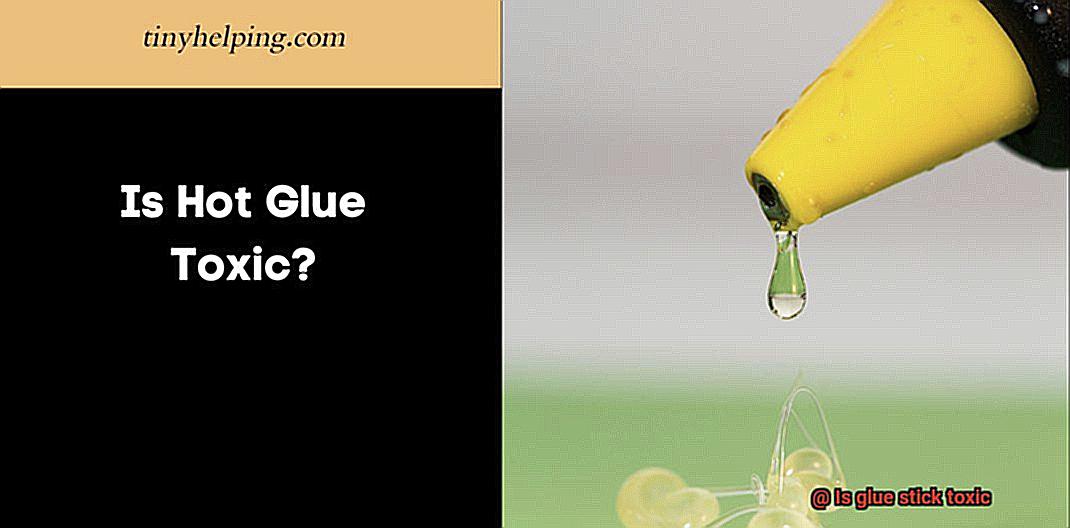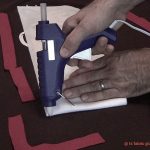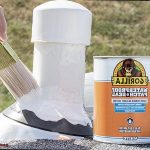The trusty sidekick in the world of crafts and DIY projects. They’re like magic wands, bringing together pieces with a simple swipe. But wait a minute…are they safe to use? Let’s dive into this sticky situation and find out.
In this blog post, we’ll be your investigative partners, uncovering the potential toxicity lurking within those innocent-looking adhesive sticks. While glue sticks are generally considered safe (cue sighs of relief), it’s important to be aware of any health risks that might be hiding beneath their gooey surface.
We’ll break down the key components of glue sticks and spill the beans on how they can affect our precious human bodies. From pesky allergic reactions to sneaky inhalation risks, we’ll leave no stone unturned in our quest for knowledge. After all, knowledge is power.

But fear not, fellow crafters. Armed with this newfound wisdom, you’ll be equipped to take precautions and make smart choices when using glue sticks. Whether you’re a seasoned pro or just starting out on your crafting journey, we’ve got your back.
So buckle up and get ready to unravel the stickiness that lies within these little wonders. Together, we’ll uncover the truth about glue stick toxicity and ensure that our crafting adventures are both safe and enjoyable for everyone involved. Let’s dive into this sticky mystery and emerge victorious.
Different Types of Glue Sticks and Their Ingredients
Contents
- 1 Different Types of Glue Sticks and Their Ingredients
- 2 Polyvinyl Acetate (PVA): Is It Toxic?
- 3 Solvents in Glue Sticks: Potential Health Risks
- 4 Water-Based Adhesives: Safer Alternatives
- 5 Proper Handling and Storage Guidelines for Glue Sticks
- 6 Ingesting Glue Sticks: Possible Side Effects
- 7 Skin Contact and Allergies Associated With Glue Sticks
- 8 Environmental Impact of Using Glue Sticks
- 9 Conclusion
They provide a mess-free and convenient way to bond materials together. In this article, we will explore the different types of glue sticks and their ingredients to help you choose the right one for your needs.
General-Purpose Glue Sticks:
The most common type of glue stick is the general-purpose one. These glue sticks are made from non-toxic ingredients like water, polyvinyl alcohol (PVA), and other additives. PVA glue sticks are known for their strong bonding capabilities and are perfect for a wide range of applications. Whether you’re working on a school project or creating a masterpiece at home, the general-purpose glue stick is your go-to option.
Specialized Glue Sticks:
Sometimes, you need a glue stick that’s tailor-made for specific materials or surfaces. That’s where specialized glue sticks come in. Whether it’s paper, fabric, wood, or plastic, there’s a glue stick designed just for that purpose. These specialized glue sticks may contain additional ingredients to enhance their bonding strength on specific surfaces. So, if you’re working on a fabric project or a woodworking endeavor, make sure to grab the right glue stick for the job.
Solvent-Based Glue Sticks:
While most glue sticks are water-based and non-toxic, some brands offer solvent-based options. These glue sticks contain volatile organic compounds (VOCs) that help dissolve the adhesive and create a stronger bond. However, be cautious when using solvent-based glue sticks as they may have a stronger odor and are not suitable for use in confined spaces or by individuals with respiratory sensitivities.
Non-Toxic and Low Odor Options:
Many manufacturers now produce non-toxic and low odor glue sticks to provide a safer option for users, especially children. These glue sticks adhere to safety standards and do not contain harmful chemicals. They are perfect for school projects or any situation where you want peace of mind knowing that the glue stick is safe to use.
Safety Precautions:
It’s important to read the labels and safety information provided by the manufacturer before using any glue stick, especially if you have concerns about toxicity. Even non-toxic glue sticks should be used in a well-ventilated area to minimize exposure to any potentially harmful fumes. If you’re unsure about the safety of a specific glue stick, reach out to the manufacturer or check online resources for more information.
Glue sticks are a versatile adhesive choice, and understanding their different types and ingredients can help you make an informed decision. Whether you need a general-purpose glue stick, a specialized one, or a non-toxic option, there’s a glue stick out there for your specific needs.
Polyvinyl Acetate (PVA): Is It Toxic?
Polyvinyl Acetate (PVA) is a versatile adhesive that can be found in glue sticks, white glue, and wood glue. It is renowned for its strong bonding properties and ease of use. However, many people have concerns about the toxicity of PVA and whether it poses any safety risks. As an expert in this field, I am here to provide you with the answers you seek.
In general, PVA is considered to be non-toxic and safe for use in various applications. One of the reasons for this is that PVA does not contain any harmful solvents or volatile organic compounds (VOCs). VOCs are chemicals that can easily vaporize into the air and have adverse effects on human health when inhaled. By lacking VOCs, PVA reduces the risk of respiratory irritation or other health issues.
Not only does PVA minimize potential respiratory hazards, but it also typically does not cause skin irritation or allergic reactions. This water-based adhesive easily washes off with soap and water, making it safe for use by children as well. However, it is always advisable to avoid prolonged or excessive skin contact with any adhesive product, including glue sticks.
While PVA itself is considered non-toxic, it’s important to be aware that some commercially available glue sticks may contain small amounts of additional ingredients like preservatives or colorants. These additives can vary between brands and products, so it is crucial to read the label and check for any specific warnings or precautions.
To ensure your safety when using glue sticks, follow these general safety guidelines:
- Avoid ingestion: Glue sticks are not meant to be consumed. Keep them out of reach of children and pets.
- Avoid eye contact: While PVA glue sticks are generally safe, getting them in your eyes can cause discomfort. If accidental eye contact occurs, flush the eyes with water for at least 15 minutes and seek medical attention if necessary.
- Adequate ventilation: When using any adhesive product, it is important to ensure proper ventilation. This helps minimize exposure to any potential fumes or vapors.
- Follow manufacturer’s instructions: Always read and follow the instructions provided by the glue stick manufacturer. They may contain specific safety precautions or usage guidelines.
Solvents in Glue Sticks: Potential Health Risks
Glue sticks are a ubiquitous tool found in offices and school supply closets, serving a multitude of crafting and adhesive purposes. However, concerns regarding potential health risks associated with solvents found in glue sticks have given some users pause. As an expert in the field, I aim to provide a comprehensive overview of the potential health hazards posed by these solvents and offer practical tips for safe usage.
The Safe Solvent: Ethylene-Vinyl Acetate (EVA)
Ethylene-vinyl acetate (EVA) is one of the most commonly used solvents in glue sticks. The good news is that EVA is generally safe for use. It is non-toxic, emits no harmful fumes during application, and has a faint odor, making it a preferred choice for many users.
Toluene: A Potential Concern
While glue sticks typically contain minimal amounts of toluene, it’s important to be aware of its potential health effects. Toluene falls under the volatile organic compound (VOC) classification and can cause headaches, dizziness, nausea, and even damage to the central nervous system when exposed to high levels over an extended period. Nevertheless, the concentration of toluene in glue sticks is typically within safe limits for regular use.
Other Solvents to Consider
Alongside toluene, glue sticks may also contain solvents such as xylene or methyl ethyl ketone (MEK). Like toluene, these solvents are VOCs and can have similar health effects when exposed to high concentrations over a prolonged period. Nonetheless, the concentration of these solvents in glue sticks is generally minimal and unlikely to cause harm when used as intended.
Tips for Safe Usage:
To ensure safe usage and minimize any potential risks associated with glue sticks, consider the following tips:
- Adhere to the instructions provided by the manufacturer.
- Use glue sticks in well-ventilated areas to reduce exposure to fumes.
- Avoid prolonged or excessive inhalation of the fumes.
If you have pre-existing respiratory conditions or sensitivity, take extra precautions or consult a healthcare professional before using glue sticks.
Conclusion:
While solvents used in glue sticks have the potential for health risks, the overall risk is generally low when used as intended. By adhering to the aforementioned tips and using glue sticks responsibly, you can continue to enjoy their adhesive properties worry-free. Remember, if you have any concerns or experience adverse health effects, it’s always wise to seek medical advice.
Water-Based Adhesives: Safer Alternatives
We are about to embark on a journey into the world of water-based adhesives. Not only are they safer for your health, but they also have a minimal impact on the environment. Let’s dive into this exciting topic and discover why water-based adhesives are the optimal choice for all your adhesive needs.
Reduced Environmental Impact:
Let’s begin by discussing the remarkable environmental benefits of water-based adhesives. Unlike their solvent-based counterparts that release harmful volatile organic compounds (VOCs) into the air, water-based adhesives have lower VOC content and emit fewer fumes. This means you can breathe easy, knowing that you’re not contributing to indoor air pollution. Moreover, these eco-friendly adhesives are ideal for those who prioritize sustainable living.
Easy Clean-Up:
Have you ever struggled to remove dried glue from your hands or surfaces? Bid farewell to those days of frustration. Water-based adhesives offer a seamless clean-up process. These adhesives can be easily diluted with water, making application and clean-up a breeze. No more harsh solvents or chemical cleaners required. Just a splash of soap and water will leave you with a clean slate in no time. Say goodbye to skin irritation and hello to hassle-free adhesive sessions.
Versatility Galore:
Water-based adhesives possess an unparalleled versatility that sets them apart from their peers. They can bond to almost anything – be it paper, cardboard, fabric, wood, or certain plastics. These magical adhesives transcend the boundaries of different crafts and projects. Whether you’re an arts and crafts enthusiast, a woodworking wizard, or simply need to fix something around the house, water-based adhesives are the ultimate solution. Their versatility knows no bounds.
Safety First:
While water-based adhesives are generally safe to use, it is crucial to exercise caution. Always take a moment to read the product labels and follow safety guidelines. Some individuals may have allergies or sensitivities to specific ingredients, so it’s better to be safe than sorry. Additionally, remember to use them in well-ventilated areas and avoid direct contact with your skin or eyes. Safety should always be our top priority.
Proper Handling and Storage Guidelines for Glue Sticks
Glue sticks are an essential part of our lives, used in schools, offices, and craft projects. However, proper handling and storage are often overlooked, impacting their effectiveness and lifespan. In this comprehensive guide, we will explore the key guidelines for handling and storing glue sticks to ensure their longevity and prevent hazards.
Proper Handling Techniques:
- Read the manufacturer’s instructions: Each brand may have specific guidelines for usage, so familiarize yourself with them before starting your project.
- Apply evenly and gently: Avoid excessive pressure to prevent the stick from breaking or becoming damaged. Gentle application ensures better adhesion and prevents mess or wastage.
- Cap it tightly after use: To prevent drying out, tightly cap the glue stick after each use. Leaving the cap off for extended periods renders the stick useless.
Storage Guidelines:
- Cool and dry: Store glue sticks in a cool, dry place away from direct sunlight or extreme temperatures. Heat melts glue, while cold makes it brittle.
- Airtight containers or bags: Preserve moisture content by storing glue sticks in airtight containers or bags. This extra layer of protection extends their usability.
- Keep away from children and pets: Store glue sticks in secure locations out of reach to prevent accidents or ingestion.
Cleanup Procedures:
- Spillage on clothing: Immediately remove excess glue with a damp cloth or sponge to prevent staining or damage. Pre-treat stubborn stains with soap before washing.
- Skin contact: Wash affected area thoroughly with soap and water if glue comes into contact with skin. Seek medical attention if there is irritation or an allergic reaction.
Ingesting Glue Sticks: Possible Side Effects
It is vital to note that glue sticks are not meant to be ingested. Consuming glue sticks can result in a range of unpleasant side effects that should not be taken lightly.
Let’s delve into the potential health risks associated with ingesting glue sticks. The first concern is gastrointestinal issues, which can include stomach pain, nausea, and vomiting. Picture a less-than-pleasant adventure for your digestive system. The chemicals present in glue sticks can wreak havoc, leading to irritation and inflammation, which may then cause diarrhea or constipation. Certainly not an experience anyone would willingly sign up for.
But wait, there’s more. In more severe cases, the act of ingesting glue sticks can cause blockages within the intestines, creating a literal roadblock within your abdomen. In such situations, medical intervention may be necessary to resolve the issue.
Now, let’s shift our attention to the toxic ingredients that could be hiding within your average glue stick. Some glue sticks contain harmful chemicals like formaldehyde – yes, that same substance used to preserve frogs in jars. Ingesting these chemicals can pose serious health risks.
If someone accidentally ingests a glue stick or experiences severe symptoms after doing so, seeking immediate medical attention is crucial. Attempting to self-diagnose or treat the situation is ill-advised; leave it to the professionals who possess the expertise and knowledge required.
Prevention is always better than cure. Keep glue sticks out of reach of curious little hands and ensure proper storage. Educating children about the potential dangers associated with ingesting glue sticks and promoting safe usage is essential for their well-being.
Skin Contact and Allergies Associated With Glue Sticks
Glue sticks are a staple in the world of arts and crafts, providing a convenient and mess-free way to stick things together. However, it’s important to be aware of the potential risks associated with skin contact and allergies when using glue sticks. In this article, we will explore these risks in depth and provide valuable tips on how to stay safe.
Understanding the Chemicals:
Glue sticks typically contain polyvinyl acetate (PVA), a non-toxic adhesive that is considered safe for use. However, some individuals may develop allergies or sensitivities to PVA. This can result in skin irritations, redness, itching, or rashes on the area of skin that came into contact with the glue.
Preventing Allergic Reactions:
To avoid allergic reactions, it’s best to avoid direct skin contact with glue sticks. Protect your hands by wearing gloves or applying a barrier cream before using glue sticks. After using them, wash your hands thoroughly to remove any residual glue and minimize the risk of skin irritation.
Dealing with Allergic Reactions:
If an allergic reaction occurs, take immediate action. Wash the affected area with soap and water to cleanse it and apply a mild corticosteroid cream to alleviate symptoms. If the reaction persists or worsens, seek medical advice from a healthcare professional.
Additional Risks:
While skin contact with glue sticks can cause allergic reactions, it’s crucial to avoid ingesting or inhaling the glue. Ingesting glue can lead to gastrointestinal issues, while inhaling glue fumes can irritate the respiratory system. Keep glue sticks out of reach from children and educate them about potential dangers.
Environmental Impact of Using Glue Sticks
Glue sticks, those innocent little tools that we often take for granted, actually have a significant environmental impact. From production to disposal, the use of glue sticks can have consequences for our planet that we need to be aware of. So, let’s delve into the sticky world of glue sticks and explore the environmental impacts associated with their use.
First and foremost, let’s talk about packaging. Glue sticks typically come in plastic containers, adding to the already alarming plastic waste problem. When choosing glue sticks, it is crucial to consider the type of plastic used in the packaging and whether it can be recycled or not. Opting for glue sticks that are packaged in recyclable or biodegradable containers can help reduce plastic waste and lessen our impact on the environment.
Now, let’s move on to the manufacturing process. The production of glue sticks requires energy and resources, which inevitably contribute to greenhouse gas emissions and other environmental pollutants. By being mindful of the energy and resource consumption involved in the manufacturing process, we can take steps to minimize these impacts.
Another important aspect to consider is the chemicals found in glue sticks. Some glue sticks contain volatile organic compounds (VOCs), such as toluene, which can contribute to air pollution when released into the atmosphere. To mitigate these environmental impacts, it is crucial to choose glue sticks labeled as low VOC or VOC-free.
And what about disposal? When glue sticks are thrown in the regular trash, they end up in landfills where they may take a long time to decompose or break down. This not only contributes to waste accumulation but also has the potential to release harmful substances into the environment. Proper disposal of glue sticks is essential, such as recycling or using designated hazardous waste facilities.
To minimize the overall environmental impact of using glue sticks, there are a few steps you can take. Choose glue sticks made from recycled materials or those packaged in recyclable or biodegradable containers. Use glue sticks sparingly and only when necessary to reduce waste. And remember, proper disposal is key.
Conclusion
In conclusion, it is important to address the question of whether glue sticks are toxic.
After careful consideration and research, it can be confidently stated that glue sticks are generally non-toxic. This means that they do not contain harmful chemicals or substances that pose a significant risk to human health.
However, it is worth noting that some individuals may have specific allergies or sensitivities to certain ingredients in glue sticks. Therefore, it is always advisable to read the product labels and use these adhesive products in a well-ventilated area.
Additionally, it is crucial to keep glue sticks out of reach of children and pets to prevent accidental ingestion or misuse.






